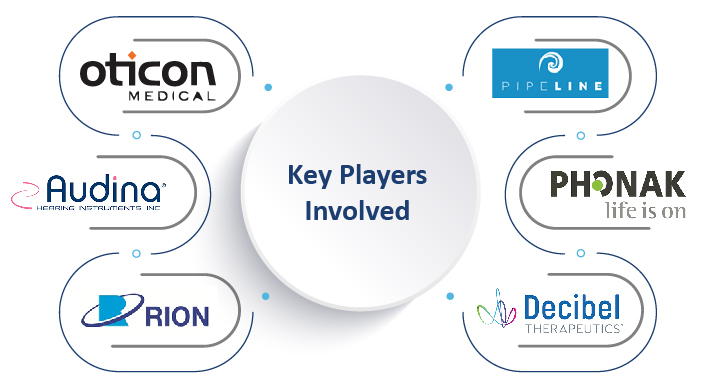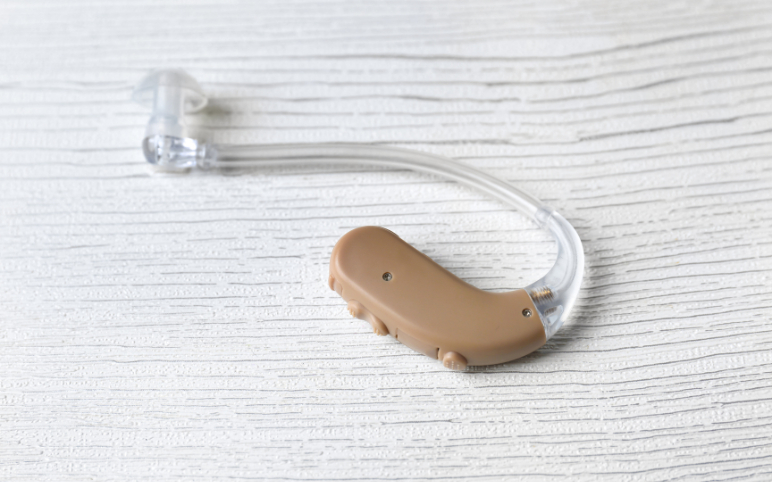Age-related Hearing Loss Device Market Dynamics Expected to Step into Growth Quadrant
Jun 18, 2021
Table of Contents
Age-related hearing loss (ARHL), also known as presbycusis, is a complicated disease that has been observed in tens of millions of people around the world. It is defined as a progressive, irreversible, and symmetrical bilateral neurosensory hearing loss caused by cochlea degeneration, in which sound-induced vibrations are translated into electrical impulses by sensory hair cells within cochlear neurons, which then help transmit information to the brain. The condition has been one of the most prevalent chronic conditions that as affected the aged population, including half of them that are over the age of 65 years in United States. In the peripheral region, the AHL develops as the result of defective functioning of the cochlear region, the auditory portion of the inner ear. There are both genetic and environmental factors that are held responsible for presbycusis.
Based on the analysis of temporal bone, in terms of the patterns of hearing loss with defective location, Schuknecht had provided three major forms of ARHL:
Downloads
Click Here To Get the Article in PDF
- Sensory presbycusis: It can be represented as an abrupt pure-tone threshold elevation in the high frequencies and hair-cell loss at the basal end of the cochlea.
- Strial presbycusis: It is found in patients with a flat or slightly descending pure-tone audiogram, correlated with atrophy of the stria vascularis.
- Neural presbycusis: It is characterized by the loss of cochlear neurons throughout the entire cochlea.
Causes of Age-related hearing loss
The tiny hair cells that are inside the inner ear help an individual to hear. They pick up sound waves and transform them into nerve signals, which the brain interprets as sound. Hearing loss takes place when the tiny cells get damaged or die. The hair cells do not regrow; therefore, the hearing loss that is caused by the hair cell damage is always permanent. There is no single observed cause of Age-related hearing loss. Mostly, it is caused by the alterations that happen in the inner ear, which occurs as the individuals grow older. The genes and the loud noises play an essential role in developing age-related hearing loss. Various factors contribute to Age-related hearing loss:
- The family history (age-related hearing loss that is hereditary)
- The repeated exposure of individuals to loud noises.
- Another cause of age-related hearing loss is smoking. Smokers are more prone to such age-related hearing loss than non-smokers.
- Some medical conditions, for instance diabetes.
- Some medicines involve chemotherapy drugs, for instance, cancer.
Different types of Treatments through Medical Devices
- Hearing aids
Hearing aids are compact electrical devices that can be worn behind or in the ear. Hearing aids assist in increasing the volume of sound. It enables a person with hearing loss to listen, speak, and actively participate in daily activities. It enhances hearing in both quiet and noisy environments. A microphone, amplifier, and speaker are the three components of a hearing aid. The microphone in the hearing aid collects sound waves, converts them to electric signals, and then sends them to the amplifier. The amplifier generally increases the signal’s power before sending it to the ear via a speaker—for instance, Oticon Ruby and Oticon Xceed by Oticon Medical, among others.
As per Delveinsight’s analysis, it is estimated that the maximum number of people that are suffering from age-related hearing loss chose the option of hearing aids, as they are much affordable and accessible, and there is no such requirement of undergoing surgery.
- Cochlear implants
Cochlear implants are miniature-sized devices that are implanted surgically in the inner ear and provide a sense of sound to individuals that are profoundly deaf or hard-of-hearing. If the hearing loss in an individual is severe, he can be recommended a cochlear implant in both ears. Examples include the Naída CI Q Series from Advanced Bionics.
As per Delvesinsight’s secondary and primary analysis, an individual is only eligible for the option of cochlear implants when he is experiencing interrupted spoken communication, minimalistic benefits are obtained from hearing aids, and the person is not suffering from any such underlying medical conditions that are known to increase the risks associated with cochlear implants.
- Bone anchored hearing systems
They are passed through the ear canal, and the middle ear and are constructed in such a way that they can use the body’s natural ability for transferring sound through bone conduction. The sound processor takes up the sound, transforms it into vibrations, and they send the vibrations via the individual’s skull bone to the inner region of the ear. As an example, the Ponto 3 SuperPower was developed by Oticon Medical.
As per Delveinsight’s estimates, for patients who are not able to use regular hearing aids, a bone conducting hearing implant may provide a better solution to their hearing loss; however, this has very less patient share as the physicians recommend hearing aids and cochlear implants the most.
- Assistive listening devices
These include telephones and cell phone amplifying devices, smartphone or tablet “apps,” and closed-circuit systems (hearing loop systems) at places of worship, theaters, and auditoriums.
- Lip reading/ Speech-reading
It is considered to be an option, which is helpful in individuals that are dealing with hearing problems and allows them to understand conversational speech. Patients who use this method pay great attention to other people’s lips and body gestures when they’re talking, allowing them to grasp what they’re saying.
Eligible patient population
Age-related hearing loss is referred to as the gradual loss of hearing in both ears. The disorder is encountered in every three adults that are over the age of 65 years. According to a study conducted by the University Ramón Llull, Barcelona (Spain), the prevalence of age-related hereditary loss is observed to be highly variable, the percentage of people which are in between the age of 65 to 75 years, range in between 15% to 25% and it is found to be in between 27% to 44% in adults over the age group of 75 years. It has been found that, in between 80-90 years, this percentage increases to 45% and 55%, respectively.
As per the National Institute of Deafness and Other Communication Disorders (NIDCD), Age-related hearing loss is said to be the loss of hearing in both the ears that tends to occur gradually as the individuals tend to grow older. Almost 30 to 35% of individuals that are in the age group of 65 and older tend to have age-related hearing loss. It has also been stated that 40-50% of people that are 75 and older have Age-related hearing loss.
As per Delveinsight’s assumptions that were taken from the research study that was conducted by Goman et al., the prevalence of hearing loss as per mild severity ranges to be about 69%, moderately severe is about 26%, and severe cases that range about 4% and about 1% are the profound cases for age-related hereditary loss across the 7MM region.
As per DelveInsight’s Age-related hearing loss device market forecast, the estimated patient pool population in 7MM. In the year 2018, the total eligible patient population for Age-related Hearing Loss was 60,652,513 cases in seven major markets and is expected to increase at a cumulative annual growth rate (CAGR) to reach 71,793,214 cases by 2026. The highest prevalent cases of this disease were observed in the United States.
Delveinsight’s analysis of Age-related hearing loss and the eligible patient population clearly showed that the maximum number of people that were observed in terms of age-specific prevalent population for the disease was comprised of adults that were >75 years of age from the year 2018 to 2026. In gender-specific prevalent population (2018-2026), that was eligible for Age-related hearing loss, the number of males had the maximum device market share, followed by females.
Emerging Age-related hearing loss Medical Devices
Envoy Medical Corporation’s Acclaim Cochlear Implant is an implanted device that received FDA Breakthrough Device Designation in June 2020. The Acclaim is the first cochlear implanted device of its kind, and it will differ from standard cochlear implanted devices, which are partially implanted and feature an external microphone and processor. The device is currently on trial, but if authorized, it will be the first without any external components to provide users with unique benefits, hence increasing cochlear implant acceptance and user compliance around the world. The Acclaim cochlear implant utilizes the unique sensor technology from the fully implanted Esteem osseointegrated active middle ear implant.
Recent Age-related hearing loss Device Market Activity
- On February 18, 2021, Signia announced the release of their new Motion Charge&Go X hearing aid line, which includes the groundbreaking Motion Charge&Go SP X — a rechargeable super-power hearing aid that has approx. 61 hours of run-time per every charge.
- On July 07, 2020, Cochlear Limited had declared that Kanso 2 Sound Processor, the Nucleus 7 Sound Processor for Nucleus 22 Implant recipients, and the Custom Sound Pro fitting software received premarket approval.
- On June 17, 2019, the new CochlearTM Nucleus® ProfileTM plus Series Cochlear Implant and the Nucleus 7 Sound Processor’s enhanced built-in connectivity featuring direct streaming with compatible AndroidTM smartphones were approved by the US FDA.
Major Key Players


A glimpse of the current and future scenario
The current research related to Age-associated hearing loss relies on novel strategies, which are related to the electrode array, thereby improvising neuronal health and spatial selectivity and reducing consumption of power. The future designs that are to be offered in this Age-related hearing loss device market are assumed to improvise neuronal health by implying a reduction in insertion trauma, reducing the inflammatory pathway which follows electrode insertion, or via the use of neurotrophins or stem cells. Further improvements that are associated with spatial selectivity and in recognition of speech within challenging listening environments can be seen through changes in the electrode or the neural interface. The use of an array to help push the electrodes closer to the neural tissue, as well as changing the stimulation mechanism with current steering or even optical or piezoelectric stimulations, are all considered. Improving the MRI compatibility is also a significant consideration, and devices that cater to remote programming have a significant impact on the worldwide provision.
Along with improvements in microchip technology at an exponential rate, the size observed of both internal and external devices is expected to grow small. Additionally, the advancements made in directional microphone technology further tend to improve the design of future devices thus, the Age-related hearing loss device market. A combination of improvements made in laser technology and use of robot operated electrical insertion for reducing the electrode insertion trauma and improvement in surgical accuracy, the goal of achieving a completely implantable device with significant advances made in the battery life will also be observed.



